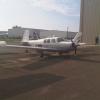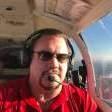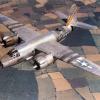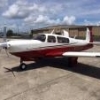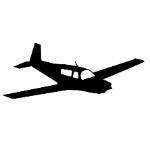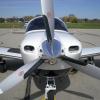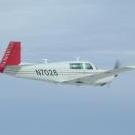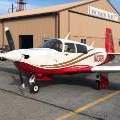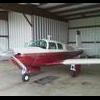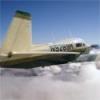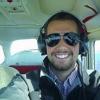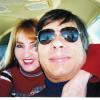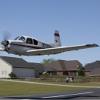Leaderboard
Popular Content
Showing content with the highest reputation on 12/08/2016 in all areas
-
you should reply with: Dear Mr. Saxena, It is with deep regret that I must inform you that the new Mooney Aircraft I was thinking about purchasing, I am no longer considering. I will be purchasing a Cirrus instead.12 points
-
Let me have your attention..Follow-up from Mooney. I just received a phone call just a few minutes ago from Vivek at Mooney Inc, well actually he was heading to a Mooney dealer up in the northeast. I was kind of caught off guard as I had just walked into work. He did relay sincerest of apologies on behalf of Mooney and said there was mis-communication with respect to tour cancellations. He said that they would gladly provide us a tour and even offered an extended hospitality of a lunch. I told him I truly appreciated the follow-up and accepted the invitation. I did not want to make them go over and beyond with the lunch offer, but would gladly accept the tour. I really would have been happy with just a abbreviated tour allowing me to stand at the entry door with my face smashed against a window looking in. He did not go into details regarding future tours, so I'm not sure of the status of that. I do appreciate his follow-up, correction and invitation. Time to close out this thread. I don't want to beat a dead horse..maybe it was mis-communication or the end of the tours. Regardless, I appreciate them following up and the special invitation. I want to post this as quickly as possible so everyone will be at peace with the outcome. Pictures will follow..I promise! Thanks for the support from MS. -Tom8 points
-
I'm sitting in the terminal at SFO waiting on the connecting flight home. I've been in Korea all week but UPS tells me a stack of boxes has been delivered to the hangar. Over the next couple of months, I hope to get an all new panel done in my 252. Going In: Aspen E1000 Pro, EA100 autopilot adaptor, Avidyne IFD540, AXP322 Remote Transponder, SkyTrax100 ADSB In, PMA450a audio panel, JPI EDM-900. Coming Out: KNS 80, GNS 530W, KR 87 ADF, KT76a transponder, WX-10a strike finder, KI-525a HSI, GMA340, JPI EDM-700, Turn coordinator, all engine instruments. According to Southwest Texas Aviation, the JPI install is already in progress. I hope to get the IFD540 and the PMA450a installed over the weekend as they're both just plug and play. The rest of the work will take a bit more time and will require a new left side panel to be cut. The last piece still under research is what to do about an electric standby AI.4 points
-
This all sounds very fishy and I suspect there is more to the story. Rather than rushing to judgement and publicly trashing the company in an open forum, why don't you wait and see if you get a reasonable response from the company? Maybe there is a valid rationale that this "Lori" didn't convey. Or maybe not. But it seems to me that it's a bit premature to drag them into the mud without some more facts. By all means, give us the rest of the story once you get it.4 points
-
Ok- the moment we've all been waiting for. Missile STC documents describing the modification requirements for the GW/envelope expansion. Straight out of my STC packet.... Edit: if anyone has questions on the Missile STC- let me know- I'll try to provide the DATA... as opposed to the speculation. this plane I'm flying has been modded since 1996... 20 years, and no structural problems. But who knows what the future brings. Judging by the engine mount and gear pieces though- is say Rocket engineering has a propensity to over-engineer if anything..., 2nd edit- I bet there would be a line around the block to modify J's with those gear parts, if it meant another 150lbs useful. Imagine- early J'a with 1200-1250lbs useful load...4 points
-
Don't discount a couple non-technical factors in this puzzle. Rocket Engineering used a different cert office than Mooney did/does, and very likely might have had different requirements for substantiation of their STC's. They might have been less rigorous, allowing a higher GW with no structural mods to the base airframe. Mooney could've been VERY reluctant to approve the GWI to the earlier J models while they were still selling J models...an early J with +160 lbs of useful load would put it in the neighborhood of 1150-1200 lbs, which is far more attractive than the later J models at 2900 lbs and 900-1000 useful loads. They intentionally would avoid a scenario that might hurt sales of new planes. I wish they would extend the approval now that the J is long out of production and not a threat to sales of current models. Sent from my VS985 4G using Tapatalk4 points
-
Okay, I have it on good authority that public plant tours were out of hand, it was becoming a full time thingy. Tours by special arrangement and for prospects are not prohibited. It's the open to the public, even non pilots that's discontinued.3 points
-
I love this thread but it's gotten WAY above my pay grade. Evolutions, TBMs, Meridians, hell even SR22s and Ovations don't fit my retirement budget! On slow business days I sometimes wonder if I shouldn't have bought a modded F instead of my J. It all makes me feel a little less sorry for those complaining about their $10 AMU maintenance bills.[emoji846] I don't begrudge you at all and consider myself blessed for simply being able to "slip the surly bonds of earth" on a whim. Sent from my iPad using Tapatalk3 points
-
There you go, someone always needs to bring an expert's opinion in and ruin all of this speculation we do. [emoji38] I have slipped my F many times over the years and never felt any concern doing so. Most of the time I am doing a slip is when some wise arse instructor is pulling the power over an airport and saying, "You just lost your engine!". I find keeping the plane high and slipping if needed is better than guessing when to turn final and hoping that I read the winds correctly. Sent from my iPad using Tapatalk3 points
-
I don't think we know nearly enough to be jumping to conclusions and speculating. Folks like Jolie Lucas, the Maxwells, Trey and Lela Hughes, Richard Simile talk almost daily with folks like Tom Bowen, Stacy Ellis, Mike Miles and other managers, If there's something big coming down or if there's a new plant tour policy we'll hear about it pretty quickly. (For myself, I've toured the plant twice and I've been surprised how open the factory has been. But it's possible that Monday is a bad day - employee meeting, OSHA inspection, delegation from PRC, who knows, and that there's no big change just a bad day for visitors.) My advice is we give this thread a rest for a few days and see what comes out. I have no intention to call the folks I've come to know.3 points
-
here is a copy and paste of what you are looking for....... I also attached the link here.... http://www.donkaye.com/donkaye.com/Bob_Krommer_on_Mooney_Slips-Part_2.html From the Mooney List December 3, 2005 by Bob Kromer SLIPPING A MOONEY Went up to the attic last night and dug through my old flight test data sheets from my Engineering Flight Test days at the factory. I did find the observed data for the slip tests I did. Looked over the data. From those test results, here is some additional information that might help answer some of the questions that have been raised: 1. The data shows that it's the airplanes that require lots of nose up trim for landing that are the most prone to experiencing the tail buffeting condition we talked about earlier when aggressively slipping at or below 85 KIAS. We simply could not get the M20J prototype to buffet in a full rudder sideslip at any CG and flap condition tested, down to 1.1 Vstall. From those test results, I think it is safe to say that the Pre-J models and the J model itself will not experience any tail buffeting/partial airflow separation over the horizontal tail in an aggressive sideslip maneuver. So the J and Pre-J models should be okay for slipping on approach. Not comfortable, and in my humble opinion not the way to fly a high performance airplane like a Mooney, but safe. 2. It's the K models (and variations ther3of) and the "long body" models that showed the possibility of inducing a partial horizontal tail airflow separation in an aggressive sideslip condition. I got it in both the Mooney/Porsche and the M20K model prototypes in the landing approach configuration. These are the airplanes that require almost full (if not full) nose up trim for a hands off, trimmed condition on final approach. (Sometime, run your pitch trim to the full nose up position on the ground and look at the negative angle of attack of the horizontal tail. Quite impressive). It's this high negative angle of attack with full nose up trim that puts the airflow over the horizontal tail at a fairly extreme condition. 3. Extending the flaps adds to the downwash angle over the horizontal tail, making the negative angle of attack over the horizontal tail even greater. Mooneys spend a lot of their time at or near forward CG. As the CG moves forward the need for more nose up trim on the approach is required for trimmed flight. So does lower airspeed. So the worse condition for aggressive slipping in the K and up models is slow, forward CG, full flaps - just like we are when configured for landing. Remember, it's anything that requires the need for more nose up trim that adds to the possibility of experiencing horizontal tail buffeting when aggressively slipping on the approach. 4. Aggressive slipping does strange things to the local airflow over the horizontal tail. The bottom line is this - the horizontal tail will see a greater negative angle of attack in the slip maneuver. So add an aggressive slip to the conditions noted in #3 above and you can experience the partial airflow separation over the horizontal tail and the resulting buffeting that we found in the flight tests. The Mooney is such a good design that there is no danger here - just a buffet in the control wheel from the elevator, a slight nose down pitching moment and a little loss of elevator effectiveness. But I want to emphasize - THIS IS NO PLACE TO BE FLYING. Add a little ice to that horizontal tail leading edge or a gusty crosswind requiring heavy elevator input and look out. That minor buffeting and airflow separation can get worse. 5. Someone asked what would happen to an airplane if the horizontal tail completely stalled. The answer - bad news. A sharp nose down pitching moment and a loss of elevator control would result. With increased airspeed as a result of the nose down pitch, the tail might start flying again and elevator effectiveness might be restored. But we're talking a loss of aircraft control here - a pilot's worse nightmare. How much altitude might be lost in this loss of control experience? A guess - 2000 feet. 6. Incidentally, ground effect helps the condition - the downwash angle over the horizontal tail is slightly reduced with the wing/flaps in ground effect. This reduces the local negative angle of attack of the air flowing over the horizontal tail - a good thing when it comes to stalling the horizontal tail. Again - the bottom line. Aggressive slips in your Pre-J or J should be okay from a safety of flight viewpoint. K models and up - margins here are thinner. Chances are you might experience some tail buffeting in the K models and up when aggressively slipping - not a place to be. From my flight test experience, I would avoid aggressive slips on approach in the K's and up. The Mooney is a wonderful design, but all designs have their limits. I certainly don't have all the answers and would never claim to be an "expert" or tell anyone how they need to fly their airplanes, but maybe some of my engineering flight test experiences at Mooney will help you better understand your airplanes. I've got lots of good data in my attic. Hope to share more of it with you in the future. Best Regards; Bob Kromer3 points
-
The problem is solved! It turns out it was the vernatherm, it was not opening nearly wide enough. The shop sent me a video of the difference between the old part and a new working on which is about to go into my plane, and it's pretty remarkable. I'll post it as soon as I have a more suitable connection to the interwebs.3 points
-
You can stall a Mooney in a slip, causing an incipient spin. Full stop, end of story. Been there, done that (under carefully controlled circumstances as part of CFI training). There is plenty enough rudder and pitch authority to do so. What's being discussed in this thread is how likely you are to enter an inadvertent, cross-controlled stall from an intentional slip on final, and how difficult the recovery would be. The answers are, "not likely", and "less so than from a skidding stall". Exactly how "likely" you are to stall while slipping on final is hard to quantify. But I certainly wouldn't hesitate to use intentional slips on final. Just a moderate slip in descending flight, at a low angle of attack, is very effective in increasing descent rate without increasing airspeed. The difference in control displacement and control "feel" between that benign maneuver, vs. actually entering a cross-controlled stall from a slipping turn, is significant. In my airplane, a slipping stall in a descent requires full rudder to the floor, and an almost unbelievable amount of back pressure (with the airplane trimmed normally for final approach). To me, it feels so far outside the realm of normal control pressures that it's hard to believe anyone could do so inadvertently. But I felt the same way about a skidding stall, and the NTSB reports are full of such accidents, so caution is always warranted. As others have noted, a stall from a slip causes the airplane to roll toward the high wing. By the time you've applied recovery inputs, the airplane is essentially wings level. If you don't apply recovery inputs, you'll eventually enter a spin, but it takes a few seconds. A stall from a skidding turn, in contrast, causes the airplane to roll toward the low wing. You can recover without exceeding 60 degrees of bank if you're primed for it to happen and immediately apply recovery inputs. But if you're not expecting it, I'd wager nearly every pilot will wind up inverted before they have time to register what just happened.3 points
-
The next day, Sunday November 20, 2016, we continued the Cuba flying adventure. Enroute to Havana, we made a stop in Nueva Gerona on the island of Isla de Juventud. From Trinidad, it was just a 1.3 hour pretty straight forward flight over water. We crossed Cayo Largo and several archipelago. About 20 minutes out from Nueva Gerona, Havana Center informs me that they can't reach Nueva Gerona Tower and asked me to try them on the radio. No luck. Tower was unresponsive. I was in the clear so I asked if I could do a visual approach into the airport uncontrolled but Center told me to continue on my clearance. As I approached the IAF, Center instructed me to enter the published hold and expect to hold for at least 20 minutes. I stated that I was unable due to fuel. In truth, I had enough reserve to hold a while and make it to Havana. What I did not have extra fuel for was to circle, make it to Havana, and then to Key West. I had just enough fuel reserve to land in Nueva Gerona, continue to Havana, and then comfortably make it to Key West without refueling once in Cuba. I was told that there would be avgas in Havana but I did not want to have to take any chances and rely strictly on this. So I said that I was unable to hold for 20 minutes. I was ready to divert to our next destination, Havana, but my dad was incessant that we had to make the stop in Nueva Gerona. Center got back to me and said that if I have the airport in sight, I can cancel and go in on my own but that he would not be able to clear my IFR into it. This is what I requested several times to do but I guess because of the language barrier was not clear. If this were the US, I would not have hesitated to cancel and continue VFR. But this is Cuba... I was not going to chance showing up at an airport against any sort of rules I might not be aware of and get detained and have my plane confiscated. Before switching to Tower (now CTAF and self-announce), Havana Center told me that the runway distance was reduced. Sure enough, almost half of the runway was marked off as threshold so I landed long. We pulled up to the deserted terminal, I picked the parking of my choosing and shut down. A minute later, a flood of bewildered airport employees came out onto the ramp. I think they could not have been in greater surprise if a UFO just landed there. The idea that an airplane could just show up when the tower was closed was beyond the scope of their imagination. Every sort of airport worker was there: baggage handlers, security, ticket agents, you name it. All that wasn't present was ATC. Nobody spoke a word of English so we were not able to clearly communicate what was going on so we began securing the airplane. As we were about ready to leave, the tower controller finally arrived. He was extremely apologetic and confessed to having abandoned his post for a "3 hour lunch." There were no scheduled flights and the concept of an unscheduled flight is non-existent. But, as bureaucratic as Cuba is, the control towers are to be manned all day. He was a bit nervous because he was supposed to be on duty, so the rest of our procedures at that airport went very smoothly. We needed a taxi to go several miles to town but had to make do with a horse carriage. This is no tourist gimmick, horse drawn carriages and bicycles are the primary means of transportation on this impoverished and remote island. We could count maybe 10 cars we had seen on the island. The main attraction of Nueva Gerona is Presidio Modelo, the Model Prison, in which Fidel Castro was imprisoned for several years during the rebellion. It is called the Model Prison because it was modeled as an exact replica of the the Stateville Penitentiary in Illinois. It is a unique design in which the prison cells line a circular perimeter around a central guard tower. The late Fidel Castro and Raul were some of the most notable prisoners held there.3 points
-
I know it's not Mooney but ...It is really cool. So last week I'm on a flight to Northern Sweden to a flight test range and our commercial carrier is beginning the descent into Stockholm. I grabbed this picture as morning broke and we were over a solid cloud deck. Even the picture doesn't do it justice...The colors were actually much more vivid than the picture shows. This is one of the reasons we get up early for that sunrise flight in our own planes ! Sure wish I could get my K model up that high to get these pics (39k ft) ! ... other than those winglets being about 10 ft tall... maybe if I put those on my Mooney....2 points
-
Mr. President-elect Trump I know you are quite busy selecting your cabinet members and other top US officials for your administration. The lower levels are not yet on your radar screen. However, I would like to be considered for the top role in the FAA as the administrator. I am an engineer, pilot and aircraft owner and extremely involved in the community. My engineering skills and aviation experience would make me an excellent choice to head up the FAA. My practical thought process would allow me to reduce rules and regulations imposed by the FAA and streamline processes to make general aviation industry more robust and profitable. I would make the FAA a leaner organization that can get things done efficiently and safely and make the organization act more like a business and less like a bureaucracy. Your consideration is greatly appreciated and I look forward to talking with one of your aides in the near future.2 points
-
My old K (261 conversion) felt far less stable in a forward slip, and after a few possible tail "burbles", I stoped doing them. My J slips more comfortably, but I seldom do them. I guess in the intervening years I have learned how to drop altitude quickly without slipping until near the runway in strong crosswinds. I am growing ever more confident in my CYA -100 AOA unit, but to a great extent, 40 years of landings (well over 20 in Mooneys) has a "feels about right" aspect that supersedes just watching instrumentation. A lot of clues here-yoke pressure, sight picture of nose relative to runway, general noise level (even with ANR headsets), perceived speed relative to runway markers, occasional scans of AOA and ASI instruments, listening for aural warnings just before touchdown. As I grow older I find experience trumps rigid adherence to "rules" and "always fly her by the numbers" thinking. I want to be at the right altitude, attitude, speed, and trim 50' from the runway threshold. How I get there comes from years of experience. Many will disagree, but It works for me. My old flight instructor taught me how to do this - "pull the hood off, and now what are you going to do?" That training is invaluable, and I still fly with him for my periodic checkouts, and he keeps setting up "almost impossible" scenarios. Almost, but not impossible. Fly lots - fly safe. Sent from my iPhone using Tapatalk2 points
-
I think is quite likely this thread contributed to your success. I know Stacey Ellis keeps up with MS, and he may well have put a bug in the new CEOs ear. It is consoling to know (or at least opine) that we have some input.2 points
-
thanks for the additional info. Glad to hear. I understand both sides, but I'm glad they made it right by you. Awesome to hear Mooney reach out to an individual, too.2 points
-
One of my favorite subjects since I do a lot of forward slips on final. Three control imputes done together role rudder and pitch down. My short rudder does not have much authority so is the limiting factor but the resultant effect has always given me the desired amount of decent and airspeed control. I don't think of it as all or nothing but the amount of altitude loss needed usually means rudder is to the floor. And yes if I have the distance from the field to establish a nice stable approach it's what I do but many places we fly are close to hills and mountains and as someone who likes lots of AGL the forward slip is a very useful tool to get down while maintaining airspeed . I also prefer it to crabbing in strong cross wind landings because it just gives me a more stable feel to the airplane2 points
-
the filling system is cheaper here http://www.chiefaircraft.com/ao-fbo-1.html than mile high. around here T tanks (320cu ft) rent for about $6 a month per tank, plus the cost of the fill. keep in mind those weigh around 130lbs each so you need some kind of cart. I haven't seen any tanks come up on craigslist for sale around here and I'm trying to sort out a cart setup for those beasts. If I could weld it'd be easier. it's a $15 delivery charge to swap the tanks out for you if you can't take them in. I think most people just use medical or welders o2.2 points
-
I like the way you're thinking. I did very much the same with my first Mooney. If I think about what a Mooney is used for, I wanted a good long distance IFR machine. That meant a proper T panel config, an HSI, a WAAS GPS, and a good autopilot. I decided I wouldn't look at anything less. I also wanted an engine in the sweet spot between 500 hours and 1000 SMOH. Beyond that I had a wish list that included ADSB, Engine monitor, speed mods (the early birds really benefit from them), paint and interior. Ideally I wanted all of this in an E and had a $50K budget. All the really nice E's were between $60K and $70K and I really didn't want to compromise. So I found a C at $48K that was everything except the ADSB and Engine monitor. I bought it and flew 400 hours in 2 years with no maintenance issues over $1000. Along the way I added the ADSB and engine monitor. Now I fly a K 252. This time I didn't buy the most expensive K252 as the most expensive models I found seemed to have spend money in the wrong places and neglected the things that matter most. But I did buy a nice one. Most of us on this board would recommend that you buy at the high end of the range. Don't stretch to get into a cheap J, rather buy the top of the range E or even C. In the long run, you'll be much happier and will have made a better investment. BTW I sold my $48K C for $50K after two years.2 points
-
Time to look up some landing gear parts... If you guys can do that, we have a couple of known STC writers around here... at least two have supplied things for our aircraft(s) This could actually be Rocket science. would it be possible to mount Bravo/Ovation legs on a J? They were improved after the L ran into weight challenges.... it might be as simple as spar change or as complex as a bolt pattern change.... Funnier things have happened along the way... Best regards, -a-2 points
-
I think that the monthly fees for tank rental would seriously decrease the savings from filling your own tank. I would watch Craigs list, etc. and try to buy one. Buying one new outright would probably ruin the economics. As far as size. The bigger the better. The larger the tank, the more refills you get out of it. If there is any way to get two tanks, "cascading" them will increase the number of fills per fill up (or the big tank(s)) You will need: (1) a gauge (cheap- anyplace, perhaps even Home Depot.), and standard fittings to "T" the gauge into the fill line. (2) A flexible line (Not too bad - Aerox or equilivant) (3) A fitting to match the one on your filling port. (More difficult, as it is not a standard fitting- Aerox will have them) (4) Fitting(s) for the big tank(s),(Cheap - from a welding supply store) and fittings to adapt the big tank fitting to the flexible line. (Standard - from Home depot) (5) Standard copper tubing and standard fittings (Only if you are cascading) Remember, handling oxygen, like aviation, is not inherently dangerous, but very unforgiving of ignorance of poor judgment. Most important, the valve in your plane where you fill it, is finiky and expensive. When you fill, if it makes a rattling sound, that valve is bouncing and will soon fail. Slow down the flow rate until the rattling stops. It takes a little time. Don't hurry it. Feel free to PM or call me for more details or clearer explanation. Don 214 207-67442 points
-
You can't spin if you don't stall and you can't stall unless you have a high AoA. The purpose of a forward slip is to loose altitude not airspeed. Keep your speed up and your nose down.2 points
-
I don't think you have enough rudder to "slip it into a stall." Perhaps if you were already hanging on the absolute verge of a stall, adding slip could throw you over the edge. However, if you are flying at normal approach angle of attack, I don't think there is any way you can slip a Mooney and get it cross controlled enough to cause a stall without changing pitch. The reason a skid can throw you into a spin is because if you stomp the rudder at relatively high aoa, as one wing accelerates, the other one decelerates. During a slip, you are not pivoting so you don't develop that problem. The only way I can see to push a plane into a spin (without pulling back or reducing power) during a slip entry is to stomp the rudder without putting in sufficient cross aileron input and in reality having a skid and a skid induced spin.2 points
-
She didn't really care about the chute. I kinda liked the idea of one, but as one person said: it had to have to chute to pass certification. Soooo I think I'll pass on the partnership, Pass on the cirrus, and keep looking at airplanes that were designed to keep flying in the first place.2 points
-
Prerequisites to a spin are stall and uncoordinated flight or excessive yaw. You are half way there because a slip is by definition uncoordinated flight with yaw input. However spins from slips are not as likely as those from skids. In a skid the bottom wing stalls first encouraging the airplane to drop into a spin very quickly. In a slip the top wing stalls first dropping to level. You have to work hard to enter a spin from a slip but it can be done.2 points
-
To the OP, if you still give a crap about this silly thread- Go to the Cessna forum and ask the exact same questions. Compare and contrast the answers here and there. Then when your choice is clear as mud, go with your gut instinct... OR, ask your wife to decide. You'll be fine either way.2 points
-
This thread reminded me of a funny joke. An elderly couple pull up to a McDonald's. The husband tells the wife he is going in for a coffee and asks if she wants anything. She says "Yeah, don't they sell some sort of fish sandwich?" He says yes and asks if she wants that and anything else. She says she wants a fish sandwich with just tarter sauce and a small coffee. She then tells him "you better write it down, you'll forget!" He says, "I won't forget, you want a fish sandwich with just tarter sauce and a small coffee". She then tells him to add an order of onion rings and again reminds him to write it down. He says he doesn't need to write it down, "you want a fish sandwich with just tarter sauce, a small coffee and an order of onion rings". With that, off he goes into the McDonald's. He returns a few minutes later and hands her a bag. In the bag she finds pancakes, hash browns and an orange juice. She looks over at him and yells "I told you to write it down! You forgot the maple syrup!" [emoji38] Sent from my iPad using Tapatalk2 points
-
My advice is to carefully look at your current flying needs and what you anticipate for the foreseeable future and buy as much airplane as you can equipped with as much avionics as possible. Don't get wrapped up in the "it sure is a purdy plane" mentality and lose sight of what you really need/want in a plane. My plane is one in which I invested in mechanically and avionics upgrades because I knew that it was a plane that meets the majority of the missions I fly now and will through retirement. It doesn't sport the prettiest paint job, nor the prettiest interior but it is mechanically sound and has avionics to suit my requirement for both capability and redundancy. I was a hardcore steam guy until two of the airport's I fly to in New York dropped their VOR approaches in favor of RNAV ones. Other than sitting in the dummy seat as a safety pilot, I had never flown an RNAV approach before 2012. So, when I made the jump to a WAAS GPS I was pleasantly surprised at the capability it provided. And then when I added the rest of the panel, it became a whole new airplane. I absolutely love the additional situational awareness that a glass panel provides and more importantly the additional capabilities. Sitting in the plane watching the autopilot fly GPSS really helps make single pilot IFR more enjoyable. Choose wisely my friend. Sent from my iPad using Tapatalk2 points
-
Absolutely terrific outcome, very happy to thank Vivek, I expected nothing less after meeting him at the Mooney Summit. Which then requires a thank you to Mike Elliot, which then requires a thank you to MS for providing the internet venue for him to organize.1 point
-
Perfect and quite a difference between the two. Thanks for doing that. Mooney space is so cool1 point
-
Great news perhaps they received notice from Santa indicating a major concern about being unable to fulfill a Christmas wish1 point
-
Try the Washington Post and New York Times. Or twitter . . . I'm also an engineer, with 21 years experience dealing with FDA regulations at work and over nine years dealing with FAA paperwork as a hobby. Let me know if you need help, I have a variety of sharp knives to cut red tape.1 point
-
May have been a miscommunication. May have been something else. But they made it right, quite promptly. They get credit for that.1 point
-
Dave -- I think you meant 430s installed. You will need to make sure that ForeFlight has a bluetooth (I think it is bluetooth, not Wifi) with the Flighstream 210. ForeFlight Mobile needs version 7.3 and above. This is the compatibility matrix: https://support.foreflight.com/hc/en-us/articles/206948527-What-information-will-the-Garmin-Flight-Stream-110-210-provide-to-ForeFlight-Mobile- Here is the detailed instructions on how to make it work: https://blog.foreflight.com/2015/09/14/foreflight-two-way-flight-plan-transfer-garmin-avionics/1 point
-
Best to future proof as they say these days, just go strait to the TBM-950.1 point
-
So it is JUST BUSINESS then? O.K. Can I "blame them" for making a business decision? No. Can I question that decision's true impact and think to myself...Self, Mooney is doing pretty poorly if they can't afford a minimum wage tour guide once a week...once a month vs. cancelling pre-scheduled tours to save $15 bucks in labor... Self thinks it was a poor business decision that likely has greater ramifications regarding the "Mooney Brand". Sad. Sorry you and your dad are missing out on the experience that involved flying your Mooney and "Supporting the BRAND". Actions have consequences. Thank you for sharing.1 point
-
1 point
-
Jerry, Use high altitude and bring along a person like a MAPA CFII... mount the go-pro and hang some tell-tales on the horizontal tail surfaces. how do we experience tail stalls? It is possible to look up the explanation since the one known accident occurred with a Mooney test pilot on board. Expect that it was a combination of full flaps and the right AOA the dirty air on the tail should become noticeable under the right slip conditions. This sounds like getting ice on the tail, enough ice to generate a tail stall, the nose will point to the ground very quickly. this is stuff I have only heard of, I have never experienced a tail stall. I liked the full slips with the M20C, but I had the short rudder and full throw of the 65 model... it would run out of strength on windy days. Whenever the rudder is held out into the wind, it works really well as a brake. Whether you want it to or not... Having your foot slip off the rudder as you let out of the slip is snappy. It is good to have a nice pair of shoes to have a good feel for the rudder pedals. Simple error... More thinking out loud by a PP. Not a CFI... Best regards, -a-1 point
-
Seems pretty legit, twinter has been around for several years and post frequently. The gal at mooney knew it was just him and his dad going and the new leader cancelled the tour. It's apparent by the tone the lady thinks this new, presumably permanent policy blows.....yep not smart. Sent from my iPhone using Tapatalk1 point
-
As soon as I get some Mooney time I'll let you know! Though my friend I mentioned earlier flies both and can probably already tell you. (He's on his second, so it can't be bad!) KLM - thanks for the point out! That's quite an interesting sale, seems close to fitting the bill for sure!1 point
-
That's an F?! May as well be a 787 cockpit from I'm used to looking at! Aw come on. We get at least 300-500 feet per gallon! (I guess the trade off is 13 miles per minute in a rush, but still)1 point
-
The un-Fun part of maintaining the FAA standard pilot weight.... dietary restrictions... Cutting back on the starches, fried foods and preffered beverages isn't very fun or very easy. No amount of exercise can overcome an ordinary side dish of mashed potatoes or French fries or bread and a super gulp soda. I tried to run about ten miles a week without dietary restrictions. I became pretty strong, but didn't lose any weight... This knowledge comes from early school days. But trying to prove it to yourself takes a huge commitment over an extended period of time... Wait til you see how hard it is to not eat everything in the house after a good work-out or simple jog. Doubling up on the veggies instead of rice and potatoes works, but isn't easy... Like everything else that is important, seek professional advice. Strenuous exercise without guidance can lead to worse health effects than being sedentary. Low tech guidance can be found in a few places... Some grocery store chains have a dietician on staff that is available for counseling. Many gyms have trainers that are your age and have fat free lean Bodies..... Having other people in the house with snack foods and yummy beverages can add to the difficulties. Getting to know a lean friend at the gym is helpful for motivation. They put in a lot of effort and don't mind sharing their success stories, usually... For motivation for Mooney pilots to get beach bodies, find the photos of flyboy and friends on the beaches in the Bahamas... PP advice, not a diet and exercise guru... Best regards, -a-1 point
-
Low 60's on a turbocharged engine is no issue. Continental says down to 42 is airworthy and studies show you can get full horsepower lower even as low as 20 believe it or not. If you want a nice bird with low time engine with no top needed or worries on an overhaul anytime soon look at my ad. Call or text for any questions or information. http://www.controller.com/listings/aircraft/for-sale/16972143/1979-mooney-m20k-231 or1 point
-
Yep, even in China at upto 320 kph with electric outlets at your seat and very inexpensive. Although not quite all over yet, it does span most of the country - which is huge! We seems to be a long ways off here. But even on the coasts, I think we may lack the density to make it work successfully here.1 point
-
Mike on your dealings with the Cuban authorities was this in Spanish or English?. They may charge you extra for a Spanish translator. I assume you paid in cash US dollars and got your change back in pesos. I had similar experience in Spain and Latin America. You have to have your paper work stamped (after you pay) by several officers. And officers go on siesta time at noon, so avoid departing or arriving at noon. José1 point
-
I described perhaps a worst case scenario before, but was just picturing the door link. I seem to recall that the fitting clamps to the gear. Perhaps this fitting rotatated and simply needs to be rotated back.1 point
-
The amount that the gear goes up is actually controlled by the over center link (down lock) setting when the gear is down. As the links wear, and you adjust the torque, the gear does not go as deep in the well. When they wear unevenly, the gear doors will need to be adjusted and will not be symmetrical. At some point, you will run out of adjustment on both, the door and the gear. I recently had to rebush the links and this cured both. In your case, I would check that your overcenter links are still set correctly (normally checked annually) and if so, adjust the doors as others suggested.1 point

